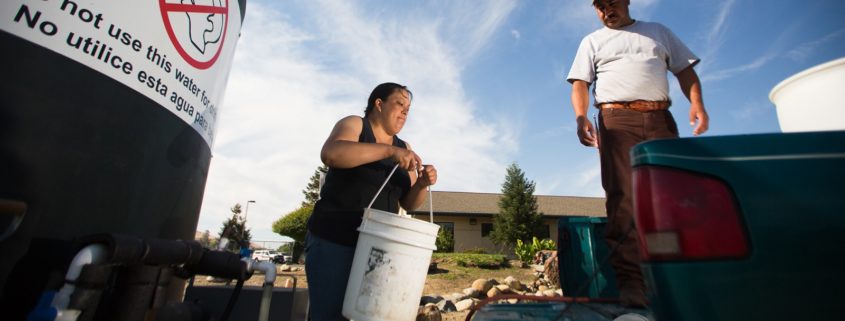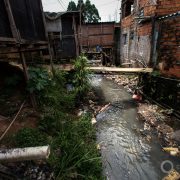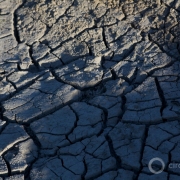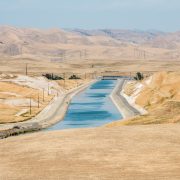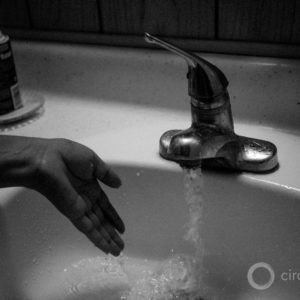Deep Drought Stirred Action on California’s Right To Water
Pioneering water law gained relevance in dry weather for solving hazards of water inequality.
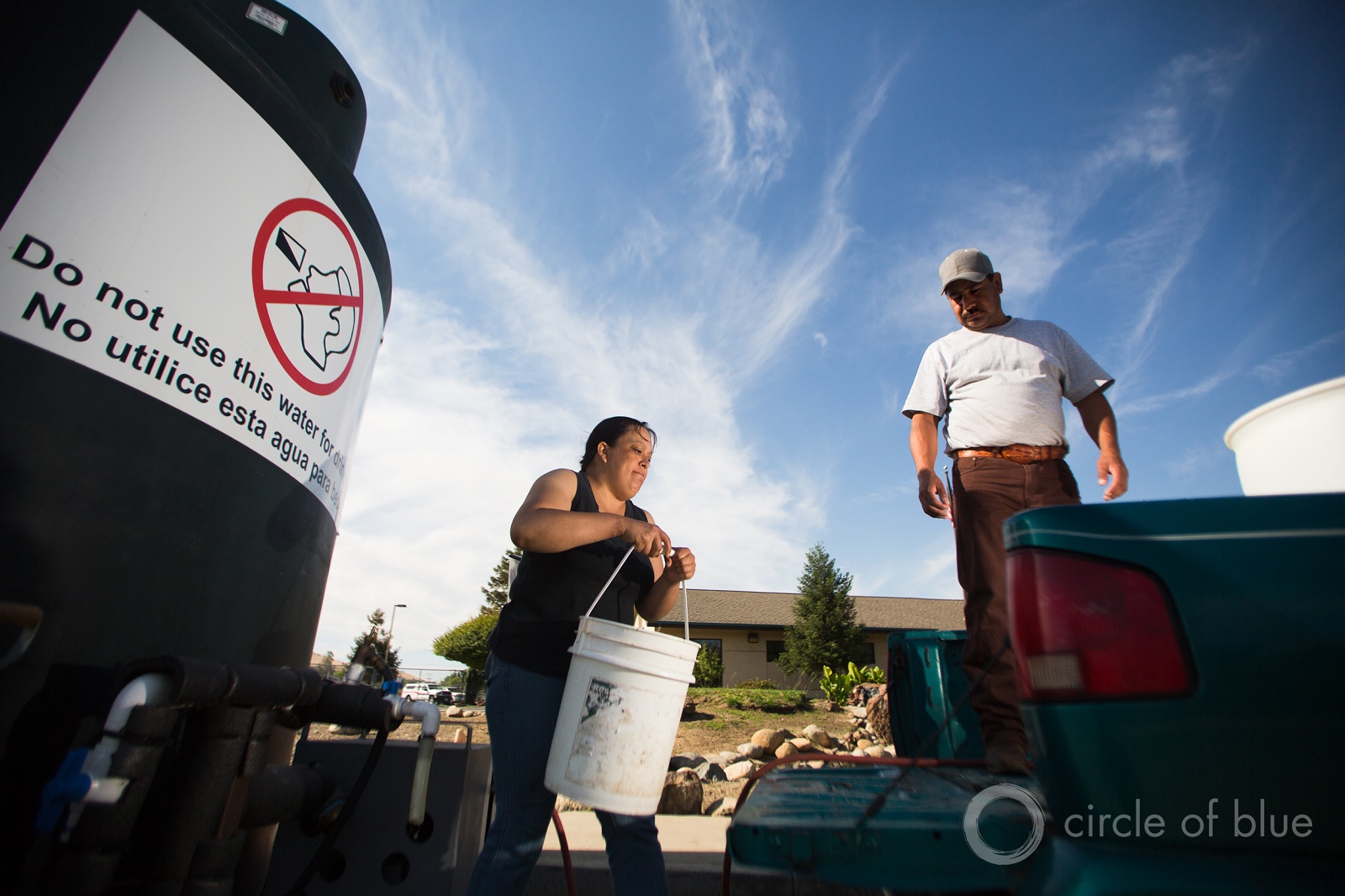
Guillermina Andrade (left) and Vicente Tapia fill five 55-gallon barrels from a water depot outside the East Porterville, California, fire station. When this photo was taken, in April 2015, the well at their nearby home had been dry for 18 months and they visited the depot twice a week for water. Photo © J. Carl Ganter / Circle of Blue
By Brett Walton, Circle of Blue
Though the nation’s first state law to assure the human right to safe water and sanitation was enacted in California in 2012, not much happened immediately afterward. The law existed in a dormant state, like a seed waiting for a storm.
The storm eventually came, but, as it happened, it was a lack of rain that brought the seed to flower.
In the first months of 2013, a tenacious zone of high pressure anchored itself in the eastern Pacific Ocean, forming an atmospheric ridge that blocked winter moisture from reaching California. More than three years of intense drought followed — years that lifted water to the center of the state’s politics and embedded right-to-water ideas deep within the government’s decision-making structures.
The drought had “a tremendous effect” on implementing the human right to water, said Max Gomberg of the State Water Resources Control Board, the agency that eventually assumed the task of championing the law. At the same time, episodes of water contamination in Flint, Toledo, and Charleston drew national news headlines and focused public attention on water pollution in urban areas.
The optics, as political consultants say, were compelling. For decades farm towns had dealt with contaminated water. But in many cases the water was clear; it still looked clean. The drought, however, was a different beast. As farmers pumped aquifers to make up for a shortfall of water in lakes and streams, thousands of wells went dry in the Central Valley, mostly in Tulare County. Suddenly, entire towns were short of water. Lines of people at portable, public showers were too much to ignore.
The drought’s catalyzing influence on state water policy is a widely shared opinion.
“Faced with people with no water, you can’t do nothing,” said Britton Schwartz, a fellow at the Environmental Law Clinic at the University of California, Berkeley. “The state had to act, to provide emergency water. In light of the law, the state had to think more sustainably. The human right to water was there at the right moment.”
Even so, right-to-water advocates thought they needed a champion agency that could put the law at the center of its work. In the summer of 2014, a realignment of state government did the trick. Until that point, water regulation was split: the Department of Public Health regulated drinking water and the State Water Board looked after water rights and pollution discharges. On July 1, 2014, regulation of drinking water shifted to the State Water Board. Water quality and water supply oversight, from source to tap, was housed within one agency.
“In California, you can pass any law you want to, but until an agency with jurisdiction adopts regulations you can’t really enforce it,” remarked Mike Eng, the Assembly member who sponsored the human right to water bill.
By the end of the drought, the State Water Board had a number of new tools and powers, largely as a result of legislative action, that put the human right to water at the center of the board’s work.
- The board established the Office of Sustainable Water Solutions, which provides technical assistance to communities that struggle to provide clean drinking water. The office has become “a powerful agent for technical assistance and data analysis,” said Colin Bailey, executive director of the Environmental Justice Coalition for Water, an organization that supports the human right to water work.
- SB 88 gave the board the authority to force a water system that is chronically incapable of providing clean water to merge with a better functioning neighbor. The law also allows the board to require a water system to extend its service lines to nearby communities that do not have sufficient water. To date, the board has mandated only one consolidation, but 32 voluntary consolidations have taken place. The law is “a little bit of a stick, but the board doesn’t always have to use it to be effective,” said Laura Feinstein, a water resources researcher at the Pacific Institute.
- AB 401 requires the board to design a state-run residential water affordability program. It would be the first such program in the nation. The board is developing a draft proposal and the final is due to the Legislature by February 1, 2018, which will determine whether and how to fund it.
- A package of three bills that are collectively called the Sustainable Groundwater Management Act ordered tighter control over groundwater pumping and quality. Local agencies are doing the frontline work, but the board has oversight authority if they fail.
- The board is also developing a data portal to identify communities with water quality violations and chronic needs for financial aid to operate and maintain their water systems.
Last year, the five-member board put in writing its acceptance of the principles that now shape its work. In a February 2016 resolution, it formally adopted the human right to water as a “core value” and a “top priority.”
“It’s part of a larger shift in making equity and environmental justice a larger focus of state government,” Gomberg explained.
Without the drought would the state have made as much progress on the human right to water? “No,” Gomberg said. “We would not be at the same point.”
Step by Step
The path now in front of state officials and lawmakers twists in several directions.
On the policy front, the Legislature is debating how to help poor communities pay for maintaining and operating their water systems. SB 623 would establish a state fund so that communities do not get into the same situation as Lanare. The town’s $1.3 million arsenic treatment plant, paid for with a federal grant, shut down in 2007, just six months after it opened, because the 589 residents could not afford to operate it.
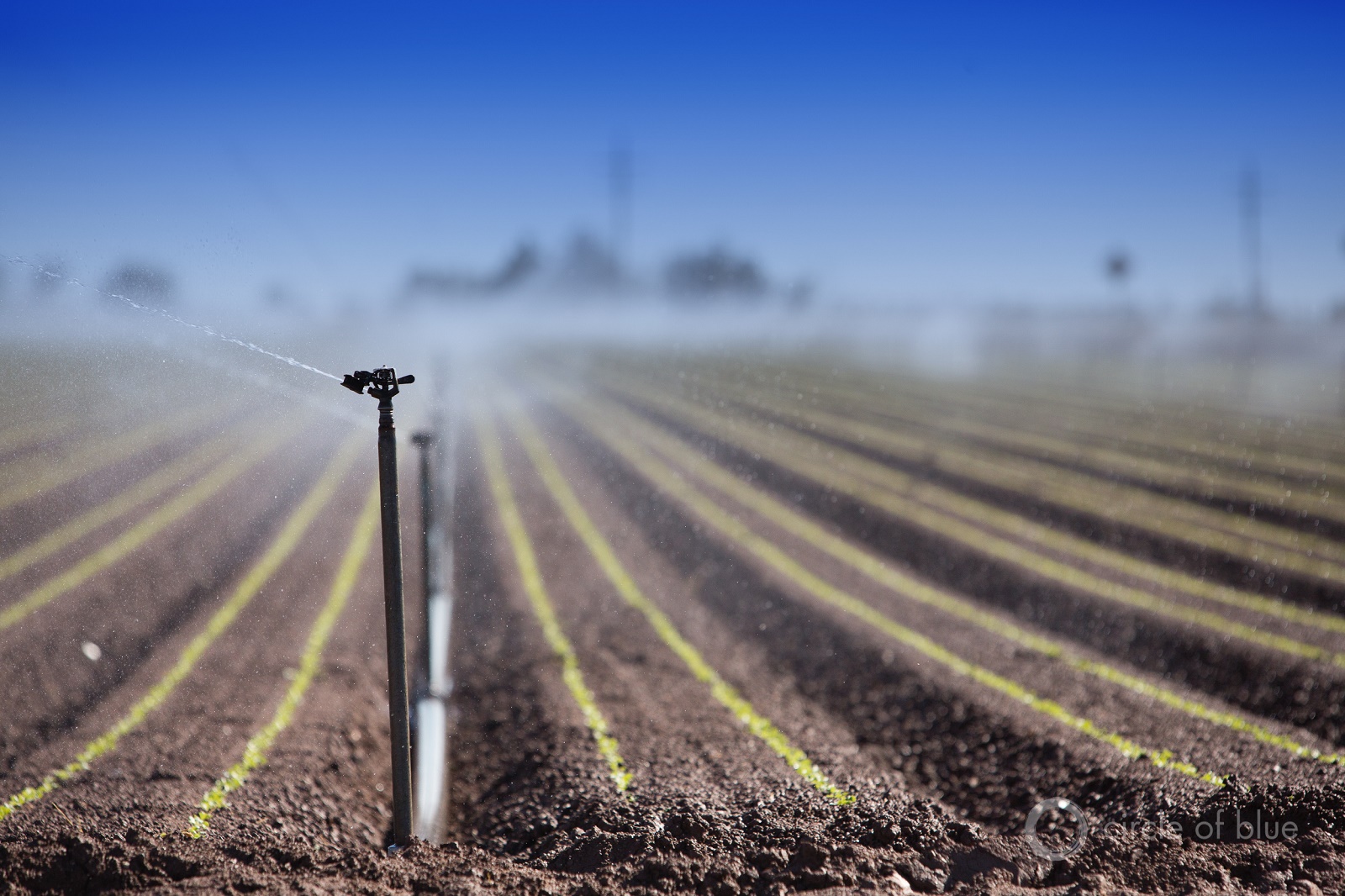
Keeping California’s $45 billion farm economy from polluting rivers and aquifers will be a challenge in securing clean drinking water. Photo © J. Carl Ganter / Circle of Blue
The State Water Board estimated last December that about $45 million per year would be needed for 309 water systems that struggle with finances and meeting water quality standards. But the board cautions that the estimate was a one-time “snapshot” and the cost will fluctuate.
Lawmakers have also ordered the State Water Board to come up with a plan for a statewide program to assist poor families with their water bills. Affordable water is one of the tenets of the human right to water law, and more than half of Californians get drinking water from a utility that does not offer an aid program.
Both SB 623 and the water affordability program will require, combined, hundreds of millions of dollars per year. Money could come from fees levied on farmers and water utility bills. Money could also come from general tax revenue. Many of the groups involved in the human right to water campaign have worked out a compromise with the farm industry and prefer the user fees approach, at least for SB 623. Residents, except for those earning less than 200 percent of the federal poverty line, would see a $0.95 charge per month on their water bills. Farmers would pay a tax on fertilizer and milk production while being exempted from penalties for their nitrate pollution, provided that they are using pollution-reducing practices.
The Association of California Water Agencies, however, supports use of the general fund for SB 623. The association, which represents large water utilities, argues that adding too many fees to water bills harms the affordability goals that are the state’s ultimate intention. If lawmakers cannot come to an agreement by September 15, the bill will roll over into the next session, in 2018.
Beyond the Legislature, water managers are asking questions that they would not necessarily have entertained before the human right to water.
“We’re using the human right to water framework to consider what it means to involve the homeless in water management,” said Mike Antos, senior watershed manager at the Santa Ana Watershed Project Authority. The authority held a symposium on the topic in June to gather ideas for updating its water plan.
That broader, more inclusive outreach is part of the democratizing action that Eng, the law’s sponsor, hoped would occur. The outreach is made possible by Prop 1, a voter-approved bond that included at least $51 million to include poor and disadvantaged communities in the regional water planning process. “The funding has driven us to build a program with much more community engagement,” Antos said.
Perhaps most difficult of all is preventing pollution in the first place. The state has been chronically incapable of controlling farm runoff and minimizing risks from the disposal of oilfield wastewater. Nitrate pollution in groundwater built up over many decades. For Horacio Amezquita, the general manager at San Jerardo Cooperative, a farmworker community in the Salinas Valley, stemming the flow of pollutants is the state’s main task. San Jerardo’s three wells were contaminated with nitrate and 1,2,3-TCP. The cooperative used bottled water from 2001 until a new water system was installed in 2010.
“People who are polluting the water claim water rights,” said Amezquita. “But when they pollute, they don’t claim rights to the pollution. Who’s going to pay for the contamination? Not everyone has high wages.”
Last month, the Environmental Justice Coalition for Water was one of nine environmental and fishing groups that sued the State Water Board for failure to curb the discharge of farm waste into rivers, groundwater, and the ocean.
“We need to get at the root causes,” said Bailey, EJCW’s executive director.
Looking to the future, Bailey and others see the state continuing the step-by-step course it has set for meeting the goals of the human right to water.
“I’m confident it will be an incremental approach, as it has been to date,” Bailey said.
Like the U.S. Constitution, which calls for a more perfect Union, the human right to water, Bailey argues will always be a work in progress. Droughts will come and go, and climate change will increase water uncertainty, some years rapidly diminishing supplies and concentrating pollutants. Economic fortunes will rise and fall, requiring some communities or individuals to need a helping hand.
“It’s a progressive realization,” Bailey said about the human right to water. “It’s never necessarily quite finished.”
Brett writes about agriculture, energy, infrastructure, and the politics and economics of water in the United States. He also writes the Federal Water Tap, Circle of Blue’s weekly digest of U.S. government water news. He is the winner of two Society of Environmental Journalists reporting awards, one of the top honors in American environmental journalism: first place for explanatory reporting for a series on septic system pollution in the United States(2016) and third place for beat reporting in a small market (2014). He received the Sierra Club’s Distinguished Service Award in 2018. Brett lives in Seattle, where he hikes the mountains and bakes pies. Contact Brett Walton

